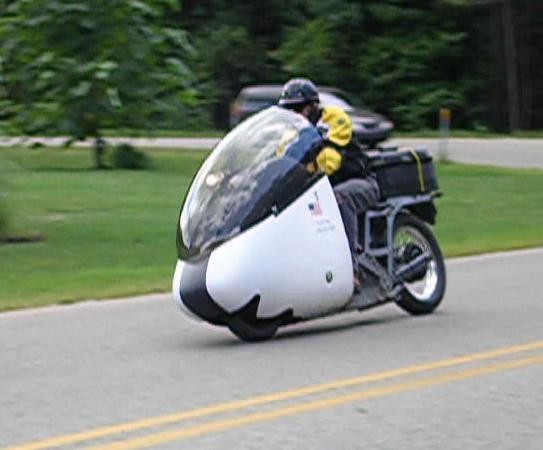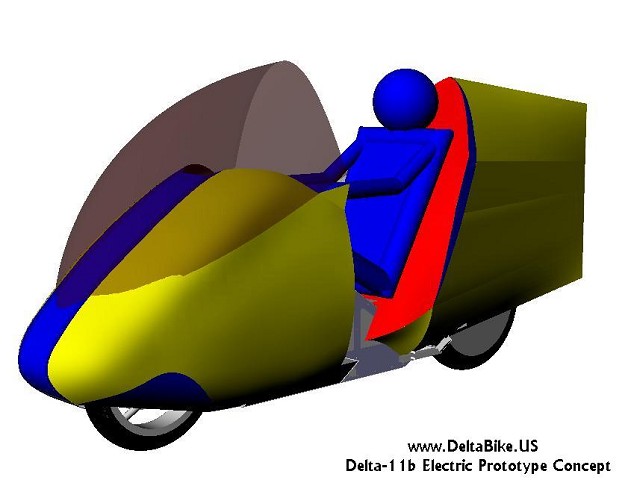|
DELTA-11: Goals for 2012 | ||
|
Body Concept for 2012 Delta-11? 2012 Delta-11 Concept: A super comfortable, high performance electric motorcycle that goes faster than you can legally drive it, has a 100 mile range and gets 800MPGe.  1,000 MPGe IS POSSIBLE! Is 300 MPGe good enough? We are shooting for a 100 mile range at 55mph. This is the equivilant of about 800MPGe with our current 8kWh battery pack. But, is reaching this goal even possible? To answer this question, we did some calculations based on the assumption that we can't do better than the NSU flying hammack that had a Coeficient of Drag Cd=.1. These calculations indicated that our bike currently has a Cd of about .65 and that we could get around 1,000MPGe with a Cd=.1. To hit our goal of 800MPGe, we will need a Cd=.15 (For reference, Craig Vetter's yellow streamliner has an estimated Cd=.45). So, we'll need to fully enclose the vehicle. To see the calculations, visit the following link: http://ecomodder.com/forum/tool-aero-rolling-resistance.php The other question to ask is, "Is it worth it from an economic standpoint? In Fuel savings, no. At 300 MPGe, it costs about $.012 per mile for electricity, at 800 mpg $.004/mile. Over the course of a riding season of 5,000 miles, you would only save $40. In initial purchase price, yes. The bike can be thousands of dollars less because it needs a smaller battery. In Range, yes. Real world range can double or triple. In recharge time, yes. Charging time will be cut in half. | ||
Status - November 1, 2011
| ||
|
Fully Enclosed Concept - Thanksgiving 2011 A Cd of .1 is required to achieve 1,000 MPGe. This requires the bike to be fully enclosed. Here is a concept of how that might be accomplished. 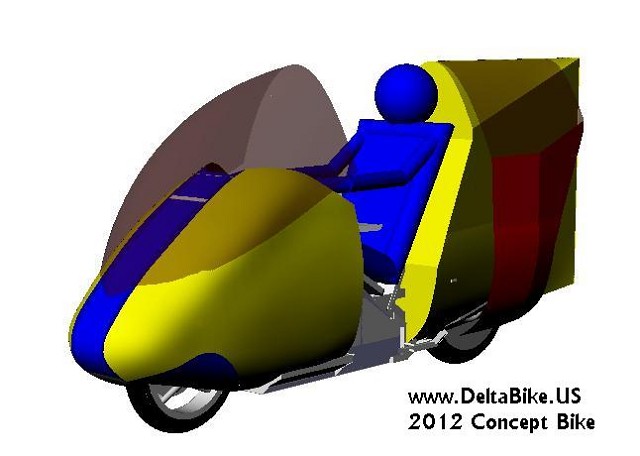 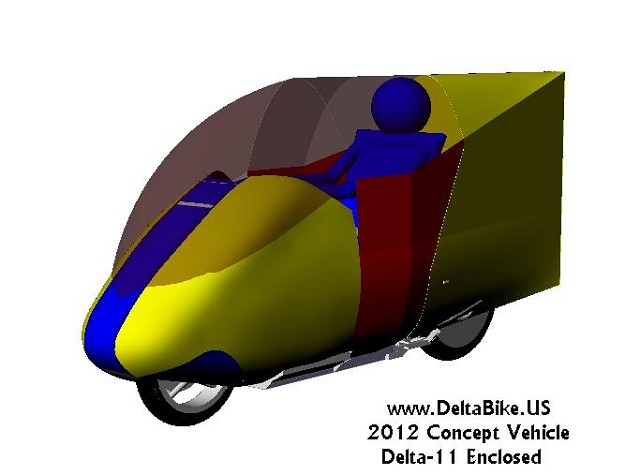  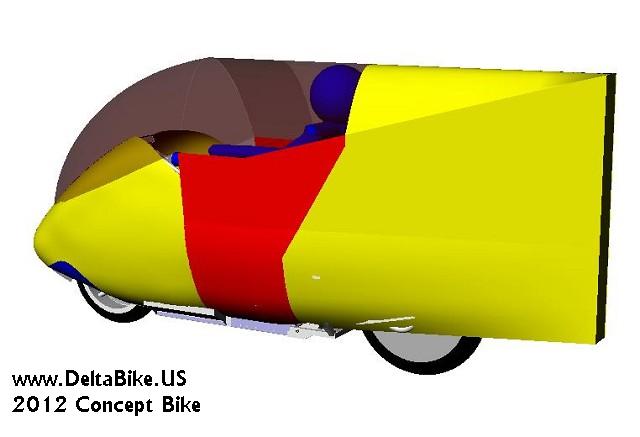 | ||
|
Cross Wind Stability Research - November 2011 An important safety issue for highly streamlined, fully enclosed, 2-wheeled, land vehicles is cross wind stability. Not a lot has been published about this, but several important benchmarks are out there. Craig Vetter's work. Royce Creasey's Work, and the Peraves Monotracer benchmark. Royce Creasey and Craig Vetter have found ways to make their open cockpit bikes stable in high crosswinds. The Peraves Monotracer has proven that a fully-enclosed, 2 wheeler can be built that is stable at speeds over 100mph. It has steering and body geometry that work together to automatically countersteer into wind gusts so that the vehicle doesn't get pushed off course. The E-Tracer gets over 200MPGe while racing with super cars on twisty roads. http://peraves.wordpress.com/2011/06/28/sportscars-of-st-moritz/ Here is our Delta-11 concept compared to Voyager 2, the Mono-Tracer and Craig Vetters bike for general size. 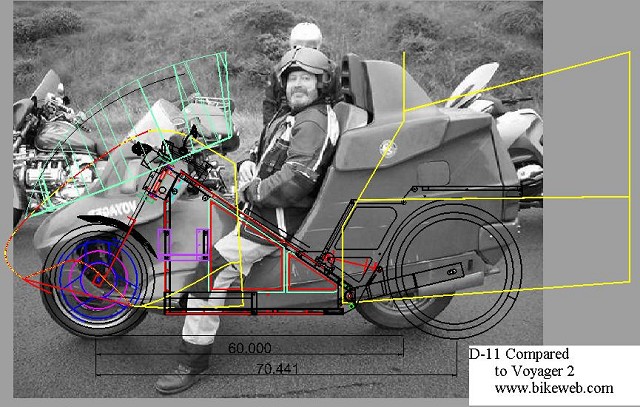 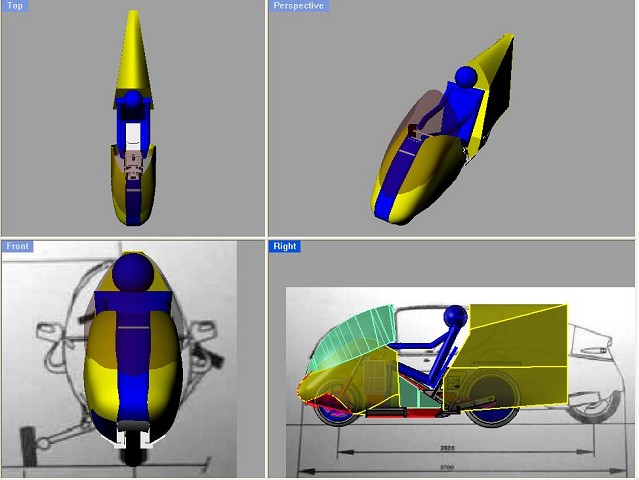 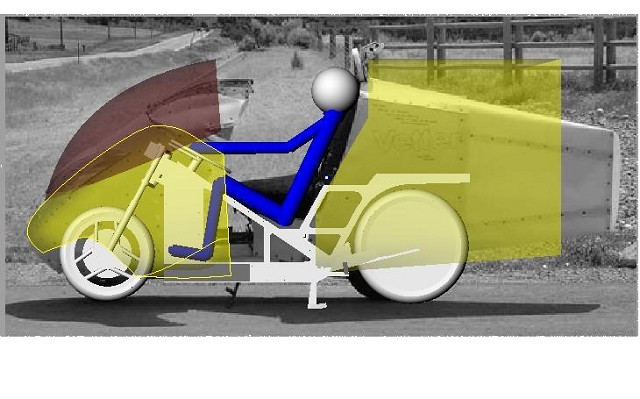 Exciting new entry is Alan Smiths third generation Ninja 250ex. Craig Vetter and Alan have been working away on bodywork for this bike for the last few months. Here is the status on March 6, 2012. 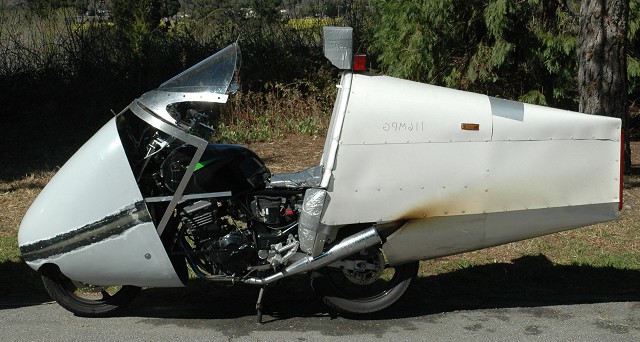 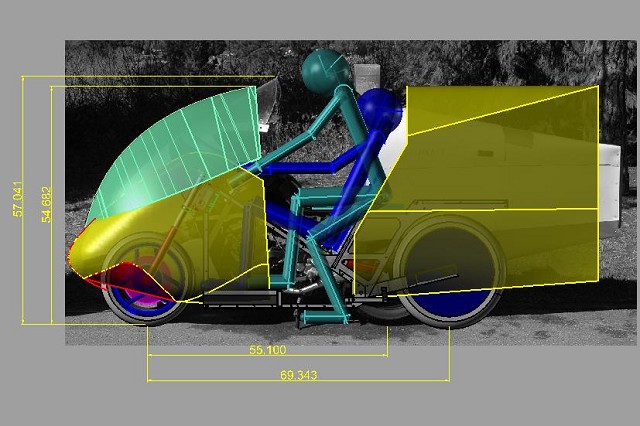 | ||
|
Realistic Prognosis for 2012 - January 1, 2012 A message from Kraig Schultz, Founder of Schultz Engineering, LLC and DeltaBike.US: So, where are we today? Our 2011 Concept Bike (i.e. the Delta-11) was a huge product development success. The bike is getting the equivalent of nearly 400 miles per gallon. But, more importantly, it's range, speed, comfort and cargo capacity make it a practical commuting and errand running vehicle. In December, we put together an interactive pricing spreadsheet for the DeltaBike website and were aghast to find that in limited quanities the current design would need to be priced at $18-$20K per bike (see http://www.deltabike.us/price.htm)! So, while the bike is the best we've built so far, it's price makes selling it much harder than it needs to be. To be a hot selling product, the electric bike needs to have superior value or performance per dollar. As of today, the electric motorcycle is not the best value $/mile. (That honor goes to the Gasoline Powered Automobile). The electric motorcycle is also not the best performance Hp/$. (That honor goes to the Gasoline Powered Motorcycle). What is the value proposition of an Electric Motorcycle? The Delta-11 concept bike already has the following traits: Superior comfort, more Joy in riding, Superior fuel economy, pride in ownership, freedom from oil. The Delta-11 concept bike has the potential to have the following traits: Better performance (acceleration and handling) than the average car, and Kick Ass Styling with true streamlining. In 2012, the Delta-11 could be a viable product if it had a 100 mile range (at 55mph) and was selling for less than $8,000. The price of the Delta-11 concept is high due to 4 key elements: 1. High Battery System Cost 2. High Motor/Controller Cost 3. High Custom Frame Cost 4. High Streamlined Body Cost. How will we address these issues? 1. As the Lithium Battery glut of 2012 develops we should see the pricing of batteries plummet. Long term, the remaining battery producers will come out with better chemistries that give us 2-4x the range / battery dollar. 2. The brushless hub motor system is about twice the price of a brushed chain driven motor system. Do improved aerodynamics, efficiencys and maintenance justify using a Hub Motor? We think so. Also, in volume, the price of these systems should drop a little. 3. Custom Frame Cost: Our waterjet, bolted together design made in low volume can obviously be greatly improved for cost and ease of manufacture. The main emphasis in 2012 must be to prove out the general shape of the frame and it's ability to safely, comfortably, and practically carry a full aerodynamic body. Production engineers will need to design a tubular, welded design that is cost effective for production. 4. Streamlined Body Cost: In low volume, this may never change. I forsee that this is one of the great attributes of the Delta-11 bike. Having an extremely cool-looking, stylized body (that is unique/customized) is something I think our customers are willing to pay for. Of course, there will be the "standard body" that can be mass produced for low cost (vacuum formed panels?). Here's a question going into 2012: What if the only thing electric motorcycles need to be viable is streamlined bodies with cargo capacity? If so, then we are really close! Any electric motorcycle (Streamlined or not) gets over 250 MPGe just because of motor and battery efficiency. On this note, I'd like to sing the praise of Streamlining for Electric motorcycles as we look toward a successful year of improvement: Streamlining offers the opportunity for the bike to have the following features: 1. Protection and comfort for rider
My primary role is not to bring the bike to production. It is to show it can be done. 2. Better Performance a. 2x range for any given battery size b. ˝ charge time for any given range c. ˝ battery cost for any given range d. ˝ battery weight for any given range e. Less battery weight = better acceleration, better fuel economy, better handling f. Higher top speed for given Horse Power g. Practically “free” to ride (fuel cost/mile<$.01/mile) 3. Cool looks (Styling) 4. Unique look for establishing a Brand 5. Advertising on body (revenue and/or stronger social voice for owner) In 2012, if I can do the following, I will be satisfied with my progress: A. Develop a body that works functionally (cross wind stable, low Cd), B. Make a functional body that looks stylish (work with stylists and body builders) C. Get the cost down to a marketable level (look at different frame designs). I've been self-funding the Research and Development of Schultz Engineering for the last five years. I do this by contracting my time as an Engineer to local companies. Lack of funding has been the number one thing holding progress back. If you believe in the value of the projects Schultz Engineering is doing, please help expedite this work by making a donation. Please join me (Next Page) | ||
|
Inventing a better tomorrow today... Copyright 2011, Schultz Engineering, LLC |
